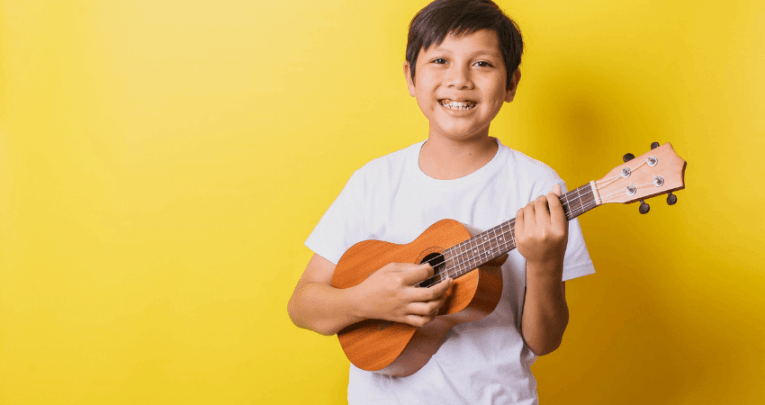Music Hub Investment Programme Newsletter by Nick Sermon
Posted on: 06/01/2023Music National Curriculum – how to take control of instrumental lessons

Control the cacophony and get your whole class playing instruments in unison, while honouring the music National Curriculum…

Share
PRIMARY SECONDARY
The last few years have seen the publication of multiple official music documents. These include The National Plan for Music Education, Model Music Curriculum (MMC) and the Ofsted Research Review. They have created a buzz of discussion throughout the music community.
Each of these documents mention, some in great detail, the implementation and impact of Whole Class Ensemble Teaching (WCET). Specifically, they highlight the importance it plays within the primary curriculum.
Since 2017, I have been privileged to be part of this, delivering both brass and ukulele lessons within my school.
So why should we be offering this opportunity and how do we inspire the next generation of musicians?
Instrumental lessons
The National Plan says that within KS1 ‘pupils should experience the mechanics of how instruments create sound, exploring simple class instruments, such as simple hand or tuned percussion and recorders.’
This should then be developed by the time they reach KS2. The plan suggests flute, violin and djembe as examples of what you can deliver.
The excitement I witness every week underpins how important this whole-class opportunity is for so many pupils across the country.
We should afford all pupils the opportunity to play an instrument, and make music alongside friends. It’s also one that we as practitioners should be facilitating.
So how do we prepare for the task of coordinating 30+ children to play as a group?
Music National Curriculum
The internet is awash with different schemes that will offer something different in every aspect.
When considering your selection, look to see if you can you try before you buy.
All the major platforms offer a free option and, as budgets are precious, this is something I strongly advise exploring.
Look at the additional aspects of these curriculums, too; can other classes benefit from the investment?
Additionally, other music teachers are now starting to develop great resources. You can access these via Teachwire, and Tes Resources – these personally have been brilliant for me.
Here, I was fortunate to stumble across Mr Gray’s Music Shop and haven’t looked back since.
You will also find that the hubs across the country have developed guidance for their teachers and schools.
Through a quick search you can locate YouTube channels and PDFs to support most instruments.
However, one size does not fit all and you will need to think carefully about your location and demographic.
What do you want as the outcome for your school? A mix of resources might be more appropriate than using just one scheme.
Take time to consider everything before you commence with the lesson.
Music lesson KS1 KS2
Singing, listening and performing are the key components for a successful lesson.
The first session is all about exposure to the instrument.
Listening activities should feature different performers. Ideally, we want pupils to see what can be produced, and an overview of how that person started.
Our goal is to show it is possible to be like those who perform music. I regularly reference Alison Balsom, Jess Gillam, Alexis Ffrench, Wycliffe Gordon and many more in conversation, underpinned by examples of their performance.
I’m constantly reminding myself that I could quite easily have the next virtuoso brass player sitting in front of me.
The first weeks of term are a key opportunity to embed the process and ensure everything is automatic.
Keep repeating processes to ensure everyone understands.
My ukulele class were not the greatest fans of the Ukulele Magic – Ukulele song, but after successive weeks of listening, all the parts were soon learned.
Other essential elements include:
Singing
Singing always features in every music lesson.
Most primary schools have packed calendars over the year, so it is easy to select a limited repertoire. However supplementing this with other pieces will give children a broad variety of genres. Think about including pieces that are traditional, modern and from overseas.
One of the most popular pieces delivered in recent years at my school was Oranges and Lemons. Pupils thoroughly enjoyed learning it, especially supported by the playground actions!
Targets
Although exposure to multiple types of music is desirable, targets should be achievable. One or two pieces performed well is better than four or five fairly average ones.
It might be that throwing in multiple songs seems like a good way of keeping the interest up. However, in the long term the establishment of skills over a few pieces will have a greater impact. Therefore, it will a better performance for the class and school to enjoy.
You can help keep your children engaged with repeating a song by including short games and tasks. Focus on rhythm and pitch.
Recording
Record everything that you do, too; this is the greatest and most effective way to show progress.
There are a variety of different secure platforms that can be used. Seesaw seems to be popular among many schools, and Stream offers the opportunity to record straight to Microsoft 365.
Essentially, whatever you do, have the evidence to share when it’s required.
Multi-sensory experiences
Lastly, don’t forget to ensure that what you deliver incorporates a multi-sensory approach.
Often, I will use five strips of masking tape to act as a stave on the classroom floor.
When you are focusing on identifying notes, ask the children to step on the stave to show you the position of the note.
Equally, if you want to describe how music will ascend and descend in pitch, this an important way to demonstrate the process.
It’s also much more interesting than just showing a piece of music with a series of black dots!
Nick Sermon is a class teacher and academy music lead. Follow Nick on Twitter @nicsermon
